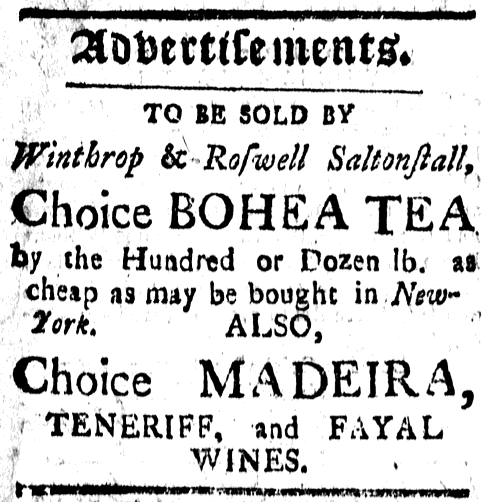What was advertised in a colonial American newspaper 250 years ago today?

“Choice MADEIRA, TENERIFE, and FAYAL WINES.”
Some newspaper advertisements presented consumers with lengthy lists of manufactured goods imported from England, but others promoted foods and beverages that originated in places outside Britain’s global empire. In the September 11, 1767, edition of the New-London Gazette, for instance, Winthrop and Roswell Saltonstall announced that they sold “Choice … WINES” imported from islands in the eastern Atlantic. Madeira and Fayal wines came from Portuguese outposts. Madeira, a fortified wine, derived its name from the main island in the Madeira archipelago. Fayal (an English variation of Faial) wines came from one of the islands in the central group of the Azores, an archipelago consisting of nine islands. Tenerife wines came from the largest of the seven Canary Islands, conquered and colonized by Spain. In consuming wines from Madeira, Tenerife, and Fayal, colonists participated in vibrant networks of exchange that crisscrossed the Atlantic. Such networks often crossed imperial boundaries, even as nation-states attempted to enforce mercantilist policies.
Given that the Saltonstalls advertised these wines in the public prints, they most likely had imported them legally. Yet a variety of commodities – sugar, molasses, rum, foodstuffs, and wine – found their way to colonial markets via smuggling. “The case of wine is a good example,” according to David Hancock. “Not just in war but also in peace, the varieties and amounts of wine available in British America were greater than those allowed by law and recorded at the customs house.”[1] As the Saltonstalls’ advertisement suggests, colonists could identify many types of wine and made associations with their places of origin. Just as they were accustomed to extensive choices when it came to textiles and housewares, they expected wine merchants to present an assortment so they could make their own selections. Without going into elaborate detail, the Saltonstalls listed three different wines to signal the diversity of their stock to prospective customers.
[1] David Hancock, “Rethinking The Economy of British America,” in The Economy of Early America: Historical Perspectives and New Directions, ed. Cathy Matson (University Park: Pennsylvania State University Press, 2006), 81.

